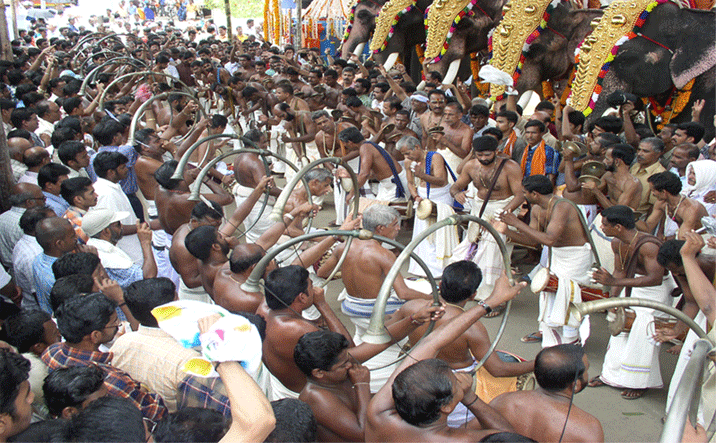- Panchavadyam
thumb|Panchavadyam_performance_during_a_festival_in_Kerala ]Panchavadyam, literally meaning an orchestra of five instruments, is basically a temple art form has evolved in
Kerala . Of the five instruments, four --timila ,maddalam ,ilathalam andidakka -- belong to the percussion category, while the fifth one,kombu , is a wind instrument.Much like any
chenda melam, panchavadyam too is characterised by a pyramid-like rhythmic structure -- with a constantly increasing tempo coupled with a proportional decrease in the number of beats in cycles. However, in contrast to a chenda melam, panchavadyam uses different instruments (though ilathalam and kompu are common to both), is not related very closely to any temple ritual and, most importantly, permits a lot of personal improvisation while filling up the rhythmic beats on the timila, maddalam and idakka.Panchavadyam bases itself on the 14-beat adanta (also spelt atanta) thaalam (
taal ), but amusingly sticks to the pattern of the eight-beat chempata thaalam -- at least until its last parts. Its pendulum beats in the first stage total 1,792, and halves itself with each stage, making it 896 in the second, 448 in the third, 224 in the fourth and 112 in the fifth. After this, panchavadyam has a relatively loose second half with as many stages, the pendulum beats of which would now scale down to 56, 28, 14, 7 and three-and-a-half.Whether panchavadyam is originally a feudal art is still a matter of debate among scholars, but its elaborate form in vogue today came into existence in the 1930s. It was primarily the brainchild of late maddalam artistes
Venkichan Swami (Thiruvillwamala Venkateswara Iyer) and his discipleMadhava Warrier in association with late timila mastersAnnamanada Achutha Marar andChengamanad Sekhara Kurup besides, subsequently, by the late idakka masterPattirath Sankara Marar . They together dug space for a stronger foundation (the Pathikaalam), thus making pachavadyam a five-stage (kaalam) concert with an intelligent mixture of both composed and improvised parts. Spanning about two hours, it has several phrases where each set of the instruments complement the others in a manner that is more likeharmony in theWestern orchestra than the concept ofmelody inIndia . Much like in Panchari and other kinds of chenda melam, panchavadyam too has its artistes lined up in two oval-shaped halves, facing each other. However, unlike any classical chenda melam, panchavadyam seemingly gains pace in the early stages itself, thereby tending to sound more casual and breezy right from its start, beginning after three lengthy, stylised blows on the conch (shankhu).A panchavadyam is anchored and led by the timila artiste at the centre of his band of instrumentalists, behind whom line up the ilathalam players. Opposite to them stand the maddalam players in a row, and behind them are the kompu players. Idakka players, usually totalling two, stand on both sides of the aisle separating the timila and maddalam line-up. A major panchavadyam will have artistes totalling around 60.
Panchavadyam is still largely a temple art, but it has come out of its precincts to be seen performed also during non-religious occasions like cultural pagentry and according welcome to VIPs.
Major Venues of Panchavadyam
There are several central and northern Kerala temples that have been traditionally playing host to major pachavadyam performances. Prominent festivals featuring them are Thrissur pooram, Kaladi Panchavadyam ulsavam, Machattu Thiruvanikkavu vela, Nenmara-Vallangi vela, Varavoor Palakkal vela, Tirumandhamkunnu pooram purappadu, Tripunithura Poornathrayeesa aarattu and Cherpulassery Ayyappan Kavu ulsavam, besides temples in places like Chottanikkara, Odakkali, Vaikkom, Perumbavur, Pazhur, Ramamangalam, Nayathodu, Chengamanad, Chennamangalam, Irinjalakuda, Thiruvillwamala, Pallassana, Pallavoor and several renowned temples in
Malabar .Training Institutes of Panchavadyam
Some of the known institutions that give formal training in panchavadyam are
Kerala Kalamandalam and Kshetra Kalapeetham in Vaikkom.Masters of Panchavadyam
Among today's masters of panchavadyam are Kuzhoor Narayana Marar, Chandran Marar, Thrikkambaram Krishnankutty Marar, Karavattedath Narayana Marar, Koroth Ramakrishna Marar, Chottanikkara Vijayan, Nandappan, Kunissery Aniyan, Kongad Vijayan, Vaikkam Chandran, Payyannur Balakrishna Marar, Kariyannur Narayanan Namboodiri, Keezhillam Gopalakrishnan, Achuthananda Marar (all timila), Thrikkur Rajan, Cherpulassery Sivan, Thichur Vasu Varrier, Edappal Appunni Nair, Kunisseri Chandran, Chirakkala Sankara Marar, Pulappatta Balakrishnan (Kundalassery Thankamani), Sadanam Ramachandran, Kallekkulangara Krishna Varrier, Thrippalamunda Nataraja Varrier, Odakkali Sankaramani Marar, Chottanikkara Surendran, Kongad Sukumaran, Eravath Appu Marar, Kalamandalam Sasi, Peruvanam Haridas (all maddalam), Thichoor Mohanan, Thiruvillwamala Hari, Jayan, Kakkayoor Appukuttan, Chennamangalam Unni, Pallassana Sudhakaran, Ramamangalam Jayan, Payyannur Krishnamani, Payyavoor Narayana Marar, Pallimanna Rajeev (all idakka), Cheriyath Thanku Marar, Chelakkara Unnikrishnan, Maniyamparambil Mani, Kothachira Sekharan Nair, Chengamanad Paramu Nair, Pallavur Raghava Pisharody, Asiad Sasi (all ilathalam), Chengamanad Appu Nair, Machad Ramakrishnan Nair, Unni Nair, Kummath Ramankutty, Kongad Radhakrishnan, Thrippallur Sivan, Odakkali Murali, Varavoor Manikantan, Sethumadhavan and Keralassery Ramankutty (all kompu).
Prominent among the late panchavadyam masters are Annamanada Achutha Marar, Parameswara Marar, Peethambara Marar, Chengamad Sekhara Kurup, Porathuveettil Nanu Marar, Perumbilly Narayana Marar, Kesava Marar, Pallippat Narayana Marar, Chottanikkara Narayana Marar, Bahuleyan, Pazhur Damodara Marar, Pallavur Kunhukutta Marar, Makkoth Sankarankutty Marar, Pallavur Maniyan Marar (all timila), Venkichan Swami, Vellattanhoor Raman Nambisan, Punnathur Madhavan Nair, Kadavallur Sankunni Nair, Aravindakshan, Kavungal Maniyan Panikkar, Kachamkurichi Achuthan Nair, Pulamanthol Gopalakrishnan (all maddalam), Pattirath Sankara Marar, Pulapatta Narayana Marar, Sankara Marar, Velappaya Rama Marar, Pallavoor Appu Marar (all idakka).
ee also
*
Pandi Melam
*Panchari melam
*Thayambaka
*Kerala Kalamandalam External links
* [http://melam.gosree.org Melam Collections]
Wikimedia Foundation. 2010.

